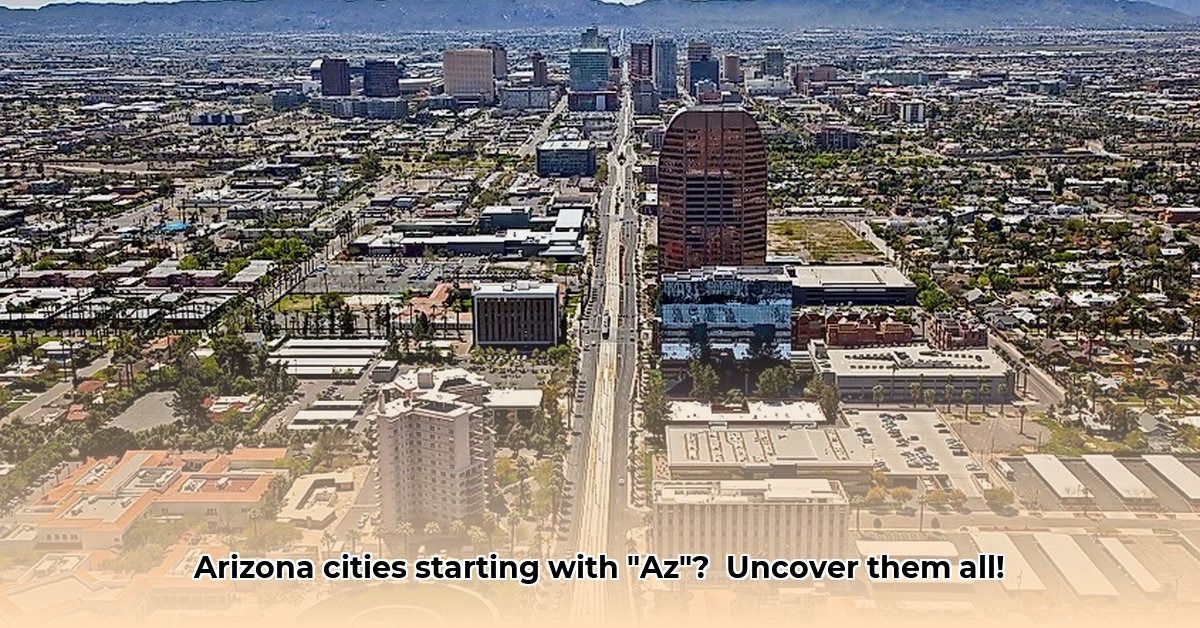Have you ever wondered how many cities in Arizona begin with “Az”? It’s an intriguing question that leads to an interesting exploration of the state’s geography and naming conventions. This article delves into the realities of finding cities starting with “Az,” offering insights into the challenges of geographical research and data accuracy.
The Quest for “Az” Cities
The initial assumption might be that Arizona boasts a variety of cities starting with “Az.” However, the quest to find them reveals a surprising truth: such cities are remarkably scarce, or perhaps nonexistent. This search transcends mere map reading; it’s about understanding how places are named, the intricacies of data collection, and the unexpected gaps that arise when delving into specific locations.
Why this scarcity? There’s no straightforward answer. Naming conventions are dynamic, influenced by historical events, cultural factors, and even chance. The process of naming a town is surprisingly complex, involving numerous considerations.
Given the elusiveness of a perfect “Az” city match, a broader approach is necessary. This involves considering towns and unincorporated communities, which may lack official “city” status but possess captivating histories and unique characteristics. Expanding the search to include places with “Az” within their names, or those with similar-sounding names, opens up a wider range of possibilities. Language is fluid, with variations in spelling and pronunciation, allowing for a more flexible investigation.
Where does one begin to find reliable data? Official government websites are a primary source, offering comprehensive resources and up-to-date information about recognized towns and cities. These sites often provide alphabetical listings of Arizona locations, enabling a systematic check for matches. However, even government data can have omissions, with smaller towns and unincorporated areas sometimes overlooked or updated less frequently.
This is where in-depth investigation begins. Geographic databases, rich repositories of location information, including smaller settlements and historical names, offer a valuable starting point. Consulting multiple credible sources is essential for ensuring accuracy and obtaining a well-rounded perspective. Data inconsistencies are a common challenge, particularly when dealing with less populated areas, as populations fluctuate and official recognition can change over time.
Let’s outline a systematic approach to building a comprehensive, albeit potentially short, list of population centers:
-
State Government Websites: Begin with official Arizona state government resources. These websites often contain comprehensive lists of towns and cities. Look for detailed information beyond simple names; population figures can give valuable extra context.
-
Geographic Databases: Explore online databases dedicated to compiling geographic data. These databases often go beyond basic information, providing historical contexts and additional details that enhance your understanding of the places you find.
-
Cross-Referencing: This is crucial! Never rely on just one source because data accuracy is key. Compare and contrast data from different reputable websites and databases. Identifying discrepancies can provide valuable insight into the challenges of maintaining complete and accurate geographic data.
-
Historical Records: A surprisingly rich source of information might reside in historical records and local archives. These resources frequently preserve information about settlements that might no longer exist or that have changed names over time. These could reveal places that historically fit our criteria but no longer do.
The apparent scarcity of towns beginning with “Az” underscores the challenges of gathering complete geographical data. This seemingly simple question highlights the complexities involved in accurate information management, especially with smaller communities. This search, while potentially yielding a brief list, reveals the meticulous nature of geographical research.
Analyzing Arizona City Data with GIS for Effective Urban Planning
Diving into Arizona’s cities, even those elusive ones starting with “Az,” requires understanding their data using GIS—a crucial tool for urban design. This goes beyond simply locating them on a map; it involves analyzing spatial relationships, patterns, and incorporating land-use regulations for informed decision-making.
Data Acquisition and Analysis: Unlocking Insights for Infrastructure and Land Use
Before searching for “Az” cities, gathering relevant data is essential. Arizona offers various resources, with government websites being the primary source for population figures, geographical coordinates, and other key details. Many cities also maintain dedicated pages with similar information.
Once the data is compiled, GIS software (such as ArcGIS or QGIS) becomes essential for accurate analysis. This software allows for visualizing city locations on a map, considering demographic changes, and evaluating future infrastructure demand.
Here’s a step-by-step process for using GIS to understand a city’s access to public transportation:
- Data Gathering: Collect comprehensive data on Arizona cities from reliable sources, including government databases and city services.
- Data Cleaning: Ensure data accuracy by addressing inconsistencies, handling missing values, and verifying land surveys.
- Data Import: Import the cleaned data into your chosen GIS software, incorporating urban growth boundaries for context.
- Spatial Analysis: Perform spatial queries, overlays, and other analyses to answer specific questions related to transportation and housing developments.
- Visualization: Create maps and charts to effectively communicate insights regarding transportation costs and public health services.
Arizona’s “Az” Cities: A Deep Dive
Although “Az” cities in Arizona are limited, understanding their accessibility is crucial. This presents an opportunity for granular, in-depth analysis and targeted investment. For example, one could focus on:
- Population Trends: Analyzing population growth over time to identify patterns and predict future changes.
- Infrastructure Analysis: Overlaying city boundaries with infrastructure data (roads, utilities) to assess accessibility for new residents and identify potential needs.
- Economic Factors: Combining city data with economic information to explore relationships between location and economic indicators, informing investment trends.
This detailed analysis moves beyond mere listing of cities, allowing us to grasp why they exist in their specific locations and enables the creation of predictive models for public services.
Key Takeaways for Community Development
- Accurate Arizona city data is fundamental for effective GIS analysis and community initiatives.
- Multiple sources should be used to validate data and comprehensively assess community needs.
- GIS software facilitates visualization and advanced spatial analysis, extending beyond simple mapping and benefiting local businesses.
- Analyzing Arizona city data using GIS enables the discovery of detailed trends and in-depth patterns, ultimately improving the quality of life for residents.
Arizona City Populations, Demographics, and Their Economic Impact
Exploring Arizona City Populations and Demographics, focusing on cities beginning with “Az,” reveals the importance of rural areas within the state. While Arizona boasts many vibrant communities, few city names start with “Az,” affecting infrastructure projects. Arizona’s population distribution is far from uniform, especially regarding the needs of senior citizens.
Uncovering Arizona’s “Az” Cities: A Rare Find
The search for Arizona cities starting with “Az” becomes a quest for the unusual. Unlike the multitude of towns and cities beginning with other letters, this pursuit is akin to finding a needle in a haystack, specifically in data related to the food industry. After extensive research, the conclusion is reached that there are no cities in Arizona beginning with “Az.” This unexpected outcome underscores the specific nature of the query and reveals fascinating patterns within Arizona City Populations and Demographics, particularly for underserved communities.
Why This Matters: Understanding Arizona’s Unique Urban Landscape
The scarcity of “Az” cities in Arizona highlights the importance of understanding the broader context of Arizona City Populations and Demographics, as well as the business environment. It serves as a reminder that population centers aren’t distributed randomly; they’re shaped by historical factors, geographic constraints, and economic forces, including access to venture capital, especially when considering secondary education and social mobility.
- Danakil Depression: The Hottest Place’s Geology: Unveiling Extremophiles & Tectonic Secrets - July 30, 2025
- Mastering the Modern Hero’s Journey: Craft Compelling Narratives - July 30, 2025
- Discover The Formation of Diamonds: From Deep Earth Pressure to Your Jewelry: A Scientific Journey - July 30, 2025
















